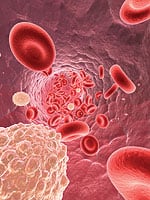Life Extension Magazine®
Cosmetic companies around the world have devoted exhaustive research efforts and massive amounts of money to perfecting unique topically-applied molecules called ceramides to help revive and hydrate aging skin. In a recent groundbreaking study researchers tested the effectiveness of a 200 mg orally-ingested formula containing wheat – derived lipids and ceramides; the results were remarkable: the formula completely restored hydration in 95% of participants suffering from dry, flaky, itchy skin!1 A growing number of published studies continue to highlight the amazing skin rejuvenating benefits of plant-derived ceramides and lipids. In this article, you will discover how these highly specialized plant lipids not only hydrate skin and combat conditions like eczema and dermatitis, but also support the structural integrity of the skin to stave off fine lines and wrinkles. Oral Plant Ceramides: Molecular Skin RegeneratorsBeginning in the early 1990s, leading cosmetic companies formulated and marketed ceramide-based topical skin-care products for treating fine lines, wrinkles, and dryness. Due to their moisture – retaining properties, ceramides were eventually added to foundation makeup and lipsticks to help moisturize and protect skin exposed to sun, wind, environmental chemicals, and the ravages of aging. While Western cosmetic companies were focusing on topical ceramide products, Japanese nutraceutical firms began employing a more innovative approach to ceramide therapy—oral delivery of ceramides in capsules, functional foods, and beverages. In 2000 oral ceramide supplements received governmental approval in Japan for general use, although Japanese women had long been ingesting concentrated ceramides in Konjac tuber, a centuries-old staple of the Asian diet.2 Ceramides also occur in human skin and their levels decline sharply with advancing age. Orally ingested plant ceramides have been shown to effectively replacethe ceramides lost through normal cell shedding, skin damage, and aging. Oral ceramides are delivered efficiently to the stratum corneum layer of the epidermis via the blood stream. Recent research suggests this oral delivery method improves the functionality of ceramides and produces results not seen in cosmetic topical applications.3 Why Your Aging Skin Needs Additional CeramidesMore than just a cosmetic problem, skin aging exposes you to significant health risks from infectious microorganisms, UV radiation, defective permeability to topical drugs, and increased susceptibility to contact dermatitis from environmental chemicals. You also need your skin to be at its functional best in order to properly regulate body temperature, synthesize optimal amounts of vitamin D, and provide critical sensory input from the environment.
Both in vitro4,5 and in vivo1,6 studies demonstrate that the moisture content of the stratum corneum in aging humans is decreased.7 In maturing individuals, the stratum corneum is also susceptible to inflammation and infection. Research shows that aging skin also suffers from reduced structural integrity due to lower lipid content—mostly a lower proportion of ceramides.5,7, 8 Studies confirm the decline of the ceramide content in aging human skin,9 possibly due to a decline in enzyme activity that helps to deliver ceramides in usable form to the skin.10 When aging skin’s ability to make ceramides diminishes, as it inevitably does, increased ceramide intake becomes essential. Increased ceramide intake is required to reverse an increased susceptibility to environmental assaults (e.g., decreased humidity, solvents, and detergents) and a diminished capacity to recover from these insults.11 Studies show that drug permeability in the aged human stratum corneum is significantly altered. Specifically, the ability of aging skin to absorb lipid soluble topical applications (including drugs) is greatly diminished.12 Maintaining an optimal concentration of ceramides in the stratum corneum is thus indispensable for supporting not only healthy skin structure, but also for maintaining healthy skin function and optimal responsiveness to delivery of topical drugs. Skin Health: Clinical StudiesA double-blind placebo-controlled study was conducted at Osaka City University to evaluate the effects of 6 weeks of treatment with oral ceramide supplements in 33 patients (6 men and 27 women) suffering from chronically dry, rough skin. The test supplement was given in the form of soft capsules containing 40 mg per day of a rice–derived lipid matrix containing ceramides. Study investigators concluded that oral delivery of natural, plant-based ceramides was safe and was directly delivered to the stratum corneum:
In another clinical study, a proprietary ceramide – rich lipid blend made from non-GMO wheat showed exceptional promise in rehydrating even chronically dry, thin, itchy skin. At the end of a 4-week, placebo controlled pilot study to determine the formula’s tolerability and clinical efficacy, 65% of participants treated with 80 mg per day of a proprietary wheat lipid complex containing ceramides experienced an increase in skin moisture compared with only 45% of the placebo group. Because it takes about 4 weeks—the entire length of the pilot study—for newly formed skin cells to migrate to the stratum corneum, improvements observed in this short time period were deemed very promising by study investigators. 1
A 90-day follow-up study tracked subjects who were recruited because of chronically dry skin, including those suffering from chronic itching. The study consisted of subjective evaluation by the participants as well as objective dermatological measurements of skin roughness, itching, flaking and hydration, determined by a test of electrical impedance and by laboratory tissue analysis. Active treatment consisted of 200 mg per day of the wheat lipid formula vs. placebo. By the end of the study, participants treated with the ceramide-rich wheat extract experienced significant softening of their skin.1 Electrical assessment of skin hydration showed improvement in 95% of the treatment group compared with no statistically significant change in the placebo group. All participants who had previously experienced chronic itching reported sharply decreased itch or complete elimination of the complaint at the study’s conclusion. Dermatological evaluation revealed a significant reduction of squames (flaking patches of skin) in the treatment group compared with the placebo group. When subsets of participants from both the active treatment and placebo groups were further examined, levels of protective lipids increased in leg tissue samples in the treatment group while no statistically significant change in levels of protective lipids was noted in the placebo group.1 A recent double-blind, randomized, placebo-controlled study was carried out on 51 women aged 20-63 years with dry to very dry skin who received either 350 mg of a proprietary wheat – derived lipid extract containing ceramides or placebo for 3 months.13 Evaluation of skin hydration on legs, arms, and face, assessed at baseline and at the study’s end, was performed using dermatological scores (dryness, roughness, reddening), skin hydration measurement, and self-assessment scores. Skin hydration was significantly increased at the end of the study on the arms and legs in the group receiving the ceramide – rich formula compared with the placebo group. Skin dryness and redness was reduced in the treatment group, which also noted improvement in overall skin hydration. Study investigators concluded that the ceramide – rich wheat extract capsules were well tolerated by study participants. Blocking Bacterial InfectionThe skin surface represents our primary barrier to the external environment, and as such, it is our first line of defense against microbial infection. Lipids at the skin’s surface, including ceramides, comprise a major part of an antimicrobial barrier. When this barrier becomes compromised, as it inevitably does with age, numerous health conditions can arise. In atopic dermatitis, for example, ceramide concentrations in the stratum corneum are diminished.14 Individuals with atopic dermatitis generally have higher concentrations of bacteria, especially Staphylococcus aureus, on the skin surface.15 A recent study confirmed that increased colonization by the bacteria Staphylococcus aureus in atopic dermatitis is correlated with the reduction in ceramides.16 Frequently present on the skin surface, Staphylococcus aureus has significant potential for causing infections if the skin barrier function is disrupted or if the surface environment is otherwise altered.17-19 S. pyogenes is another common cause of potentially serious skin infections, including erysipelas and cellulitis, which are characterized by the spread of the bacteria into the deep layers of the skin. 20 Pseudomonas aeruginosa, another opportunistic bacterium, can infect skin wounds or functionally compromised regions of the skin.21 Relief from Dermatitis and EczemaAtopic dermatitis, like other inflammatory skin conditions, is an immunologic-related condition. Accordingly, topical corticosteroids and other immunosuppressive agents are mainstays of therapy, but the risk of toxicity from these agents is significant, particularly in children. One study designed to investigate the pathogenesis of allergic contact dermatitis and other inflammatory skin conditions found that repairing the breakdown in the ceramide barrier while continuing topical medications could alleviate childhood atopic dermatitis.22
In the quest to find safer therapies for contact dermatitis, investigators treated 580 patients suffering from contact or irritant dermatitis with a skin lipid mixture containing ceramides alone or in combination with topical corticosteroids until abatement for 8 weeks. Statistically significant improvement was seen in both treatment groups at weeks 4 and 8 as compared to baseline. Individuals who used ceramides in combination with topical corticosteroids experienced greater relief, compared with those who used topical corticosteroids alone.23 Another study evaluated the use of topical synthetic skin lipids and natural ceramides to treat detergent-induced dermatitis. Study results showed that although the concomitant use of both products afforded protection equal to that of healthy human skin against detergent-induced dermatitis, slightly better results were obtained with a mixture of natural ceramides than with synthetic skin lipids. Investigators believe that supplementation using an oral ceramide extract is effective in ameliorating detergent-induced dermatitis because of their structural resemblance to the lipids in the stratum corneum.24 Ceramide therapy has also proven to be effective in combating the itching and inflammation caused by eczema. In addition, ceramide treatment has been shown to normalize skin surface lipids and reduce symptoms in patients afflicted with this condition.25 Summary
Known for their ability to support aging skin, a growing body of scientific research reveals that ceramides— a family of lipid molecules naturally occurring in your skin and in plants—represent a new class of functional lipids. As a traditional component of the Asian diet, plant-derived ceramides have long been recognized for their ability to promote healthy, youthful skin, and many leading cosmetic products have thus been formulated to contain these unique plant lipids. Recently, a proprietary, non-GMO oral wheat lipid formula containing ceramides has yielded dramatic improvements in the hydration, elasticity, and youthful appearance of dry, flaky, itchy skin, with complete elimination of dryness reported by 95% of study subjects. A wide base of scientific research supports the notion that orally ingested plant ceramides can rehydrate, revive, and reinvigorate damaged and aging skin.
Editor's NoteScience continues to evolve, and new research is published daily. As such, we have a more recent article on this topic: Visible Wrinkle Reduction with Oral Plant Ceramides | |||||||
| References | |||||||
| 1 Boisnic S, Branchet M-C. Interet clinique d’un ingredient alimentaire a visee hydratante: Lipowheat™. Etude randomisee en double aveugle versus placebo. J Med Esth et Chir Derm. 2007 Dec; 34(136):239-42. 2 Available at: www.fda.gov/ohrms/dockets/dockets/95s0316/95s-0316-rpt0275-04-Udell-vol211.pdf. Accessed November 15, 2010. 3 Boisnic, Beranger JY, Branchet MC. Anti-elastase and anti-radicalar effect of ceramides. Product Research Report. Hitex. 4 Menon GK, Feingold KR, Moser AH, Brown BE, Elias PM. De novo sterologenesis in the skin. II. Regulation by cutaneous barrier requirements. J Lipid Res. 1985 Apr;26(4):418-27. 5 Leveque JL, Corcuff P, de Rigal J, Agache P. In vivo studies of the evolution of physical properties of the human skin with age. Int J Dermatol. 1984 Jun;23(5):322-9. 6 Elsner P, Wilhelm D, Maibach HI. Frictional properties of human forearm and vulvar skin: influence of age and correlation with transepidermal water loss and capacitance. Dermatologica.1990;181(2):88-91. 7 Potts RO, Buras EM, Chrisman DA Jr. Changes with age in the moisture content of human skin. J Invest Dermatol. 1984 Jan;82(1):97-100. 8 Long CC, Marks R. Stratum corneum changes in patients with senile pruritus. J Am Acad Dermatol. 1992 Oct;27(4):560-4. 9 Imokawa G, Abe A, Jin K, Higaki Y, Kawashima M, Hidano A. Decreased level of ceramides in stratum corneum of atopic dermatitis: an etiologic factor in atopic dry skin? J Invest Dermatol. 1991 Apr;96(4):523-6. 10 Yamamura T, Tezuka T. Change in sphingomyelinase activity in human epidermis during aging. J Dermatol Sci. 1990 Mar;1(2):79-83. 11 Proksch E, Brandner JM, Jensen JM. The skin: an indispensable barrier. Exp Dermatol. 2008 Dec;17(12):1063-72. 12 Malkinson FD. Studies on the percutaneous absorption of C14 labeled steroids by use of the gas-flow cell. J Invest ermatol. 1958 Jul;31(1):19-28. 13 Guillou S, Ghabri S, Jannot C, Gaillard E, Lamour I, Boisnic S. The moisturizing effect of a wheat extract food supplement on women’s skin: a randomized, double-blind placebo-controlled trial. Int J Cosmet Sci. 2010 Jul 14. 14 Imokawa G. Lipid abnormalities in atopic dermatitis. J Am Acad Dermatol. 2001 Jul;45(1 Suppl):S29-32. 15 Abeck D, Mempel M. Staphylococcus aureus colonization in atopic dermatitis and its therapeutic implications. Br J ermatol. 1998 Dec;139 Suppl 53:13-6. 16 Arikawa J, Ishibashi M, Kawashima M, Takagi Y, Ichikawa Y, Imokawa G. Decreased levels of sphingosine, a natural antimicrobial agent, may be associated with vulnerability of the stratum corneum from patients with atopic dermatitis to colonization by Staphylococcus aureus. J Invest Dermatol. 2002 Aug;119(2):433-9. 17 Thestrup-Pedersen K. Bacteria and the skin: clinical practice and therapy update. Br J Dermatol. 1998 Dec;139 Suppl 53:1-3. 18 Ladhani S. Recent developments in staphylococcal scalded skin syndrome. Clin Microbiol Infect. 2001 Jun;7(6):301-7. 19 Oncul O, Yuksel F, Altunay H, Acikel C, Celikoz B, Cavuşlu S. The evaluation of nosocomial infection during 1-year-period in the burn unit of a training hospital in Istanbul, Turkey. Burns. 2002 Dec;28(8):738-44. 20 Kolmos HJ, Svendsen RN, Nielsen SV. The surgical team as a source of postoperative wound infections caused by Streptococcus pyogenes. J Hosp Infect. 1997 Mar;35(3):207-14. 21 Murthy R, Sengupta S, Maya N, Shivananda PG. Incidence of post operative wound infection and their antibiogram in a teaching and referral hospital. Indian J Med Sci. 1998 Dec;52(12):553-5. 22 Chamlin SL, Kao J, Frieden IJ, et al. Ceramide-dominant barrier repair lipids alleviate childhood atopic dermatitis: changes in barrier function provide a sensitive indicator of disease activity. J Am Acad Dermatol. 2002 Aug;47(2):198-208. 23 Berardesca E, Barbareschi M, Veraldi S, Pimpinelli N. Evaluation of efficacy of a skin lipid mixture in patients with irritant contact dermatitis, allergic contact dermatitis or atopic dermatitis: a multicenter study. Contact Dermatitis. 2001 Nov;45(5):280-5. 24. Coderch L, De Pera M, Fonollosa J, De La Maza A, Parra J. Efficacy of stratum corneum lipid supplementation on human skin. Contact Dermatitis. 2002 Sep;47(3):139-46. 25. Eichenfield LF, Fowler JF, Rigel DS, Taylor SC. Natural advances in eczema care. Cutis. 2007 Dec;80(6 Suppl):2-16. 26. Novotny J, Hrabalek A, Vavrova K. Synthesis and structure-activity relationships of skin ceramides. Curr Med Chem. 2010;17(21):2301-24. 27. Goldstein AM, Abramovits W. Ceramides and the stratum corneum: structure, function, and new methods to promote repair. Int J Dermatol. 2003 Apr;42(4):256-9. 28. Feingold KR. The regulation and role of epidermal lipid synthesis. Adv Lipid Res. 1991;24:57-82. 29. Zettersten EM, Ghadially R, Feingold KR, Crumrine D, Elias PM. Optimal ratios of topical stratum corneum lipids improve barrier recovery in chronologically aged skin. J Am Acad Dermatol. 1997 |






